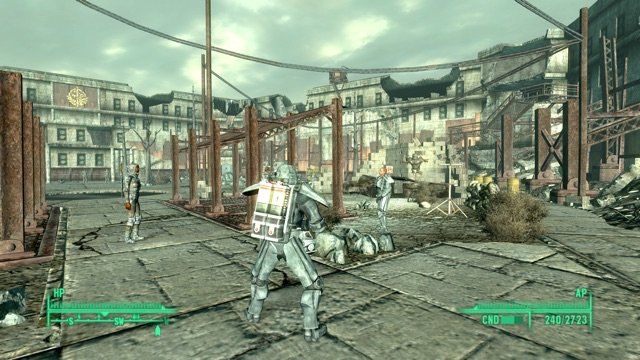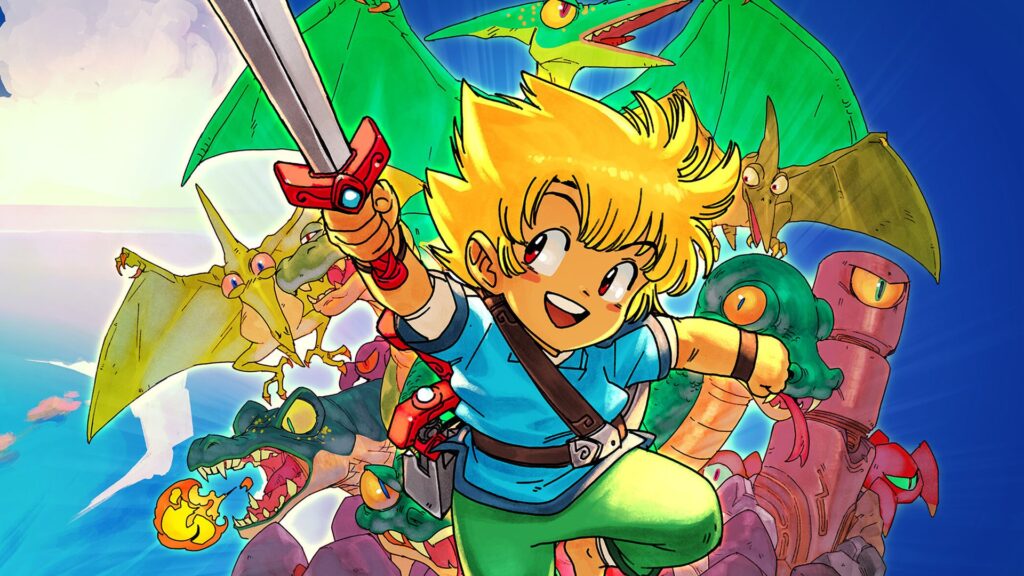In the tumultuous landscape of post-apocalyptic gaming, Bethesda’s Fallout 3 for the PlayStation 3 emerged as a seminal title, defining a generation of open-world role-playing games. Released in 2008, this installment in the Fallout series captured the hearts of players with its expansive world, morally ambiguous choices, and a narrative that unfolded like a carefully woven tapestry of despair and hope.

The Birth of the Wanderer
Fallout 3 begins with a unique introduction — the birth of the protagonist, the Lone Wanderer. Born into the confines of Vault 101, the player experiences the character’s early years within the vault, setting the stage for a journey that will unravel the mysteries of the Capital Wasteland.
As the narrative unfurls, tragedy strikes, and the Lone Wanderer is thrust into the unforgiving wasteland that was once Washington D.C. The PlayStation 3, despite its hardware limitations compared to some contemporaries, delivers a compelling visual narrative, with the dilapidated beauty of the ruined capital presented in stark contrast to the sterile interiors of Vault 101.
The Open Wasteland: A Playground of Desolation

The true brilliance of Fallout 3 lies in its open-world design, and on the PlayStation 3, this design is a testament to the creative prowess of Bethesda. The Capital Wasteland is a vast and immersive playground, a testament to the enduring power of exploration in video games.
The PlayStation 3’s hardware, though not cutting-edge in 2008, adeptly brings the wasteland to life. From the irradiated ruins of recognisable landmarks to hidden, undiscovered gems scattered across the map, each location tells a story of survival, despair, or fleeting moments of joy in the face of catastrophe.
The sense of scale is staggering, and the PlayStation 3 handles the game’s ambitious scope admirably. The draw distances may not match modern standards, but in 2008, the vistas of the wasteland, with the Washington Monument piercing the sky in the distance, were awe-inspiring.
Factions
Every good RPG has multiple factions either new or established in their game, to provide a rich world for players to explore.

- Brotherhood of Steel: finally, these power armoured warriors have experienced some growth. Led by Elder Lyons, this chapter of the Brotherhood has all but been abandoned by the others as this chapter has decided to stay and help the populous of DC. The Brotherhoods usual aim is to recover technology and destroy mutations, this group however is still doing that but for the betterment of the wasteland rather than themselves.
- Enclave: the supposed remnant of the American Government. They have been at war with the Brotherhood and in other games the NCR for years now and make another appearance here. Attempting to take over the Lone Wanderers fathers lives work and conflict ensues. Supposedly run by the elusive President John Henry Eden.
- Outcasts: sporting very cool black and red power armour this group is an off shoot from the Brotherhood of Steel. Not believing in Elder Lyons’ vision for the wasteland and clinging to the old ways this group now roam the wastes to find any technology. Although not hostile they are not friendly.
- Paradise Falls: a group of slavers stationed out of an old shopping centre. Provide work and supplies for people with negative karma, as long as you bring them some ‘stock’.
- Raiders: Mad Max inspired Raiders that take anything they please.
- Talon Company: a group of black armoured mercenaries who will be sent to track down the Lone Wanderer if their karma is too high.
- The Regulators: sporting dusters and cowboy hats this group functions as a sort of Texas Ranger, hunting the lone wanderer down if they are too evil.
- Tunnel Snakes: the lone wanderers childhood bullies from the vault.
- Underworld Ghouls: a group of ghouls have created a city in the ‘Underworld’ exhibition of the Natural History Museum in the centre of DC.
Companions
Like every good RPG Fallout 3 has a plethora of weird and wonderful companions to bring with you on your quest. Some companions in this title however will only travel with you based on your karma level.

- Dogmeat(No requirement)- you can find Dogmeat at the Scrapyard area North of Megaton. As Dogmeat is the best companion in any game they do not judge you for your actions and always stand by your side. In the horrible event that Dogmeat dies there is a perk called ‘Dogmeats puppies’ and you can find a Dogmeat puppy outside of Vault 101.
- Butch(Neutral)-the child hood bully and leader of the Tunnel Snakes from Vault 101
- Fawkes(Good)-a smart and friendly super mutant found in Vault 87. Invincible to all forms of damage.
- Charon (No requirement)-a nearly silent tough as nails ghoul bodyguard, who’s contract you can buy from a barman in the ghoul city of Underworld for 2000 caps.
- Sergeant RL-3 (Neutral) a military grade mister gutsy bot bought from a travelling robot salesman out in the wastes.
- Jericho (Evil)-a retired and disgruntled raider based out of Megaton.
- Star Paladin Cross (Good)- a Star Paladin in the Brotherhood of Steel, who met the Lone Wanderer as a child when she was part of the team that escorted your family to Vault 101.
- Clover (Evil)- a slave bodyguard paid for from the Paradise Falls slave camp.
The Karma System
At the heart of Fallout 3 lies the moral quandaries that define the player’s journey — the Karma system. Every action, every decision, resonates through the wasteland, shaping the Lone Wanderer’s identity and the world around them. The PlayStation 3 controller becomes a conduit for moral agency, with players making choices that aren’t merely binary but nuanced, reflecting the shades of grey in a world scorched by nuclear fire.
Whether it’s deciding the fate of a troubled settlement, choosing between selflessness and self-preservation, or navigating the intricate web of political intrigue in the wasteland’s various factions, Fallout 3 offers players a canvas upon which they paint their own narrative. The PlayStation 3, despite its technological limitations, seamlessly integrates these moral choices into the fabric of the game, making every decision feel weighty and significant.
Graphics and Sound
Fallout 3’s visuals, while not groundbreaking in 2008, possess a timeless quality of grey and brown. The art direction, characterized by a desaturated palette, manages to make the Capital Wasteland simultaneously beautiful and haunting. The PlayStation 3 renders the ruined landscapes with fidelity, capturing the melancholic ambiance of a world forever scarred by nuclear devastation.
Environmental storytelling is a standout feature. Crumbling buildings, makeshift settlements, and the remnants of a bygone era tell a tale of a civilization brought to its knees. The game’s attention to detail, from the rusty skeletons of cars to the twisted metal of collapsed overpasses, adds a layer of authenticity to the world.
The auditory experience in Fallout 3 is equally captivating. The haunting score, composed by Inon Zur, captures the desolation and isolation of the wasteland. The ambient sounds of distant gunfire, mutated creatures, and the mournful wind further immerse players in the world’s atmospheric richness.
The radio, a recurring motif in Fallout games, returns with tracks from the pre-war era. The juxtaposition of upbeat tunes from the 1940s against the backdrop of a devastated world is an ingenious touch, adding a layer of dark humor to the experience. All of this is helped by a fantastic radio DJ, Three Dog.
DLC
Fallout 3, renowned for its expansive open-world and compelling narrative, extended its journey through a series of downloadable content (DLC) packs. These add-ons not only expanded the narrative but also introduced fresh challenges, locales, and mysteries.

Operation Anchorage: Virtual Warfare
Operation: Anchorage stands as the first DLC for Fallout 3, offering a departure from the wasteland’s desolation. In this simulation, players experience the Battle of Anchorage, a pivotal conflict in the Fallout lore. The DLC introduces a unique gameplay style with a focus on combat and strategy rather than exploration.
The stark, wintry landscapes provide a refreshing change of scenery, showcasing the versatility of Fallout 3’s engine. However, some players found the linear nature of the simulation limiting, as it deviated from the open-world exploration that defined the main game.
The Pitt: Industrial Slavery and Moral Quagmires
The Pitt takes players to the ruins of Pittsburgh, now known as The Pitt. Here, they encounter a society grappling with issues of slavery, moral ambiguity, and a struggle for resources. The DLC introduces a morally challenging narrative, forcing players to make decisions with profound consequences.
The industrial landscape of The Pitt provides a gritty contrast to the Capital Wasteland, and the DLC’s choices contribute to Fallout 3’s overarching theme of moral ambiguity. While some criticised the relatively short duration, others praised it for its impact on the player’s moral compass.
Broken Steel: Who wants to live forever?
Broken Steel directly continues the main storyline of Fallout 3, addressing the criticism of the original ending’s lack of post-game play. In this DLC, players battle the remnants of the Enclave and witness the aftermath of their actions.
Aside from extending the game’s level cap, *Broken Steel* introduces new weapons, enemies, and quests. The decision to alter the original ending divided players, but the overall consensus was positive, as it provided a more satisfying and dynamic conclusion to the Lone Wanderer’s journey.
Point Lookout: A Southern Swampland Soiree
Point Lookout transports players to the murky swamps of Maryland, introducing a fresh and atmospheric setting. The DLC offers a mysterious storyline involving a family feud and a supernatural element, combining horror and intrigue.
The expansive and open-ended nature of Point Lookout encouraged exploration, providing a significant departure from the linear structure of some previous DLCs. The inclusion of unique weapons and enemies added to the appeal, making it a favourite among fans for its distinctive atmosphere.
Mothership Zeta: It’s probing time
Mothership Zeta takes an unexpected turn by abducting the Lone Wanderer onto an alien spacecraft. This DLC diverges from the game’s traditional themes, embracing a more sci-fi narrative. Players battle extraterrestrial foes and uncover the mysteries of alien technology.
The departure from the wasteland’s grounded reality was both praised and criticised. While some appreciated the unique setting and technology, others felt it strayed too far from Fallout’s thematic roots. Nevertheless, Mothership Zeta provided a memorable and unconventional experience.

Conclusion
Fallout 3 for the PlayStation 3 is a landmark title that transcends its technical limitations. While the hardware might not match the capabilities of more modern consoles, the game’s strengths lie in its storytelling, world-building, and the player’s agency in shaping the narrative.
A decade and a half after its release, Fallout 3 on the PlayStation 3 remains a definitive example of the power of well-crafted narratives and immersive worlds in the realm of video games. As the Lone Wanderer, players embark on a timeless odyssey through a ravaged world, leaving an indelible mark on the landscape and the gaming industry itself as strong as an atom bomb.
Joys
- Great story
- Fun characters
- The definition of a classic
Cons
- Graphics could do with a polish



